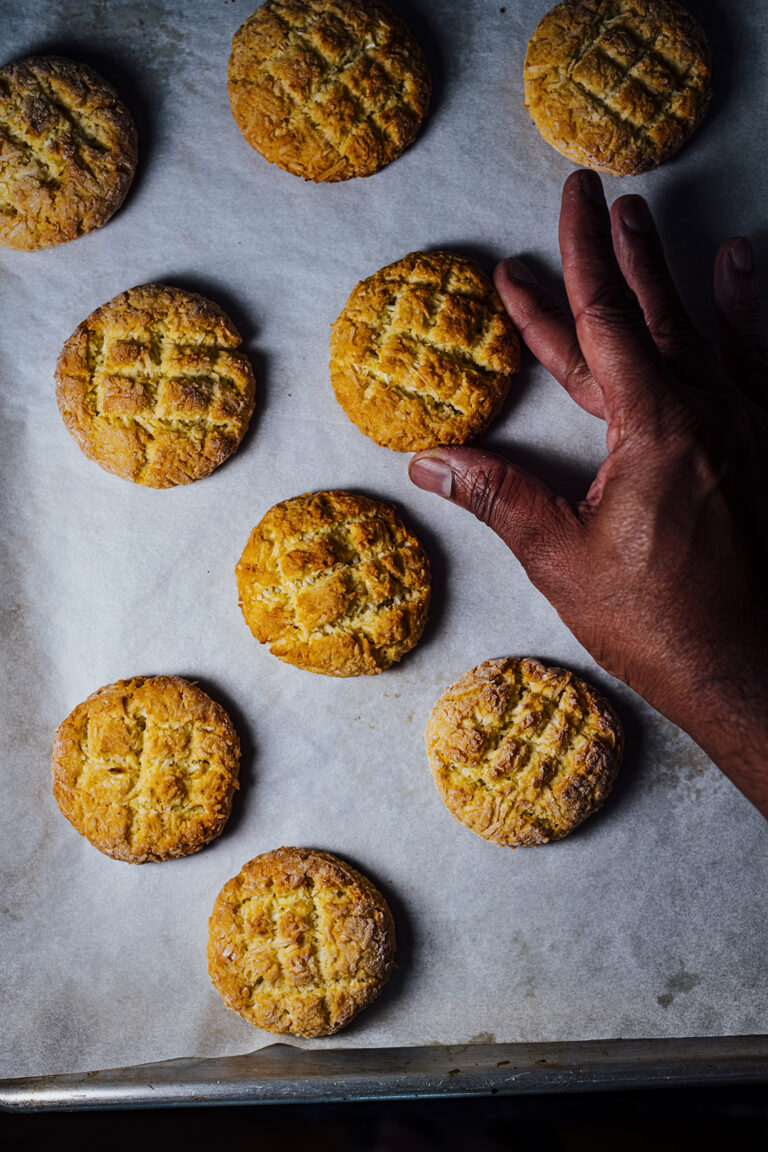Ingredients
3 cups + 2 Tbsp/250 g]unsweetened shredded desiccated coconut (see The Flavor Approach)
1 1/2 cups + 1 Tbsp/250 g]fine- grade semolina flour
1 1/4 cups/250 g sugar
2 Tbsp ghee or unsalted butter
1⁄4 tsp fine sea salt
1 1⁄2 to 2 tsp ground green cardamom
1 tsp coconut extract (optional)
3 large egg yolks plus the white of one large egg, lightly whisked together
All-purpose flour, for shaping the cookies
Instructions
- Place half of the coconut in the bowl of a food processor and grind it into a fine powder. Mix the ground coconut and remaining shredded coconut with the semolina in a large mixing bowl.
- Prepare a simple syrup by combining 1 cup plus 2 tsp/250 ml of water and the sugar in a medium saucepan and bringing to a boil over medium heat. Stir until the sugar dissolves. Add the ghee and salt and stir until the fat melts. Remove from the heat, pour the hot liquid over the semolina and coconut, and fold with a spatula until evenly combined. Cover with plastic wrap and let cool to room temperature.
- Once the semolina mixture is cooled, sprinkle on the cardamom and coconut extract, if using, and fold to combine. Add the whisked egg yolks and fold into the mixture until combined. Cover the mixture and refrigerate for at least 4 hours and up to 8 hours to let the dough firm up and absorb the flavors.
- When ready to bake, preheat the oven to 350°F/180°C and line two baking sheets with parchment paper.
- You can store the wrapped cookie dough for up to 2 weeks in the freezer. When ready to use, leave it out on the kitchen counter for about 15 minutes, until soft enough to be pliable.
- To assemble the cookies, work in batches. Lightly dust your hands with a little flour to help prevent the dough from sticking to the surface of your palms. Take about 2 Tbsp of the dough and shape it into a 1 in/2.5 cm round patty. Evenly space about 12 patties on each baking sheet. Take the blunt end of a knife and press gently to make three equally spaced parallel cuts in the center of the cookie patty. The cuts do not need to be very deep or go all the way across the diameter of the cookie. Rotate the tray and repeat to create three perpendicular cuts, creating a crosshatch pattern.
- Bake two sheets at a time for 25 to 30 minutes, until the cookies turn brown on the edges and light golden brown on top and are firm, rotating the sheets halfway through baking. Remove the sheets from the oven and transfer the cookies to a wire rack to cool completely. Repeat with the remaining cookie dough. The cooled cookies can be stored in an airtight container for up to 1 month in the refrigerator; just remember to bring them to room temperature before serving.
Notes
- The aromatic molecules in the ground green cardamom and coconut help amplify the perception of the cookie’s sweetness. You can apply this trick to other sweets too when you want to accentuate the sweetness without increasing the amount of sweetener; use aromatic ingredients and spices, such as cinnamon, nutmeg, orange blossom water, or rose water, that we commonly associate with sweets.
- The classic bolinha uses fresh coconut ground to a paste, which yields a smooth texture. I prefer the texture of shredded coconut, so I use a combination of ground and shredded.
- You can toast the desiccated coconut before it meets the semolina, but remember to cool it before you add it.
